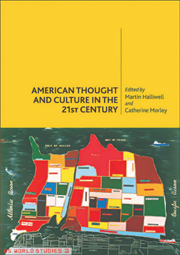Book contents
- Frontmatter
- Contents
- Acknowledgements
- Notes on the Contributors
- Introduction: The Next American Century?
- PART 1 POLITICS
- PART 2 SOCIETY
- PART 3 CULTURE
- 13 Contemporary American Culture
- 14 Cultural Pluralism and National Identity
- 15 Writing in the Wake of 9/11
- 16 American Ways of Seeing
- 17 Television and Digital Media
- 18 Animation and Digital Culture
- Bibliography
- Index
13 - Contemporary American Culture
from PART 3 - CULTURE
Published online by Cambridge University Press: 05 August 2013
- Frontmatter
- Contents
- Acknowledgements
- Notes on the Contributors
- Introduction: The Next American Century?
- PART 1 POLITICS
- PART 2 SOCIETY
- PART 3 CULTURE
- 13 Contemporary American Culture
- 14 Cultural Pluralism and National Identity
- 15 Writing in the Wake of 9/11
- 16 American Ways of Seeing
- 17 Television and Digital Media
- 18 Animation and Digital Culture
- Bibliography
- Index
Summary
Late 20th-century American culture is often characterised in terms of its plurality and eclecticism. The diversification of cultural forms, particularly in visual and digital media, and broader horizons about what constitutes cultural production have contributed to an environment in which being black, poor, female or gay (at least in theory) no longer stands in the way of talent or strength of vision. Young graduates are finding showcases for low-budget movies in the burgeoning film festival circuit; many new authors are being published, helped by the promotion of new fiction on the Oprah Winfrey Show, particularly writing by young black women; and multimedia performance and installations have extended the boundaries of what art is able to represent. Although the attempt to link cultural production to national politics can often be reductive, one framework for understanding cultural diversity in the 1990s is in terms of President Clinton's final State of the Union address. In January 2000, Clinton stressed that ‘never before has our nation enjoyed, at once, so much prosperity and social progress with so little crisis and so few external threats’. Clinton's vision was both pluralist and centrist: he saw ‘enormous potential of communities from Appalachia to the Mississippi Delta, from Watts to Pine Ridge Reservation’, but wanted to link this closely to a restoration of ‘the vital center, replacing outmoded ideologies with a new vision anchored in basic, enduring values’.
- Type
- Chapter
- Information
- American Thought and Culture in the 21st Century , pp. 211 - 226Publisher: Edinburgh University PressPrint publication year: 2008



